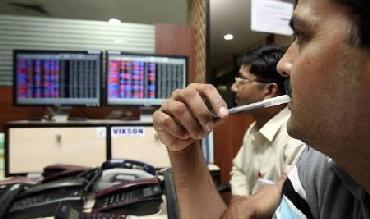 | « Back to article | Print this article |
Share trading may become cheaper
The cost of trading in shares is likely to go down. The Union finance ministry has taken up a review of the current Securities Transaction Tax (STT) regime after a meeting with top exchange officials yesterday.
While a waiver of STT in the soon-to-be-launched small and medium enterprises (SMEs) segment of the exchanges is a done deal, a similar change of rule for the equity segment was being looked into, sources in the ministry informed.
Top officials from the National Stock Exchange (NSE), Bombay Stock Exchange (BSE), MCX-SX and United Stock Exchange were present at the meeting.
Click NEXT to read more...
Share trading may become cheaper
Prior to 2008, STT was allowed as a rebate against tax liability under Section 88E of the Income Tax Act, if the income from securities on which the tax was levied was included under the head 'profits and gains of business and profession'. This allowed brokers to pay less tax and generate more volumes.
The changes to the income tax rule on STT were announced in 2008 by then finance minister P Chidambaram. This put arbitrageurs and jobbers, who generated nearly 30 per cent of volumes, out of business. Trading sentiment is at a nadir due to low liquidity.
The NSE pays a little over Rs 5,000 crore (Rs 50 billion) as annual STT and the BSE pays Rs 2,000 crore (Rs 20 billion).
Click NEXT to read more...
Share trading may become cheaper
Arbitrage trades have shifted to the commodity segment, as no transaction tax is levied. A Commodities Transaction Tax was discussed but there was intense lobbying and the finance ministry has put off the proposal.
The absence of a transaction charge in commodities has aided volumes in this segment. Average daily trades worth Rs 50,000 crore (Rs 500 billion) are generated daily.
While the cost of trading equity, including brokerage, in the US and Europe is around Rs 500 on trades worth Rs 1 crore, it is as high as Rs 1,300 in India.
Click NEXT to read more...
Share trading may become cheaper
This includes Rs 850 as STT. While Rs 200 goes to the exchange, Rs 200 is paid as stamp duty and Rs 21 as service tax. Also, Rs 10 is collected by the Securities and Exchange Board of India.
In addition, there is a brokerage. If trades are delivery-based, they attract depository and demat charges as well.
While it may seem miniscule in percentage terms, it is a major burden, as traders can make profit in India only after 28 ticks, while in the US and the UK, just one favourable tick on index futures can generate a profit.
Click NEXT to read more...
Share trading may become cheaper
In the US, the spread on the S&P contract, or one tick, is 25 cents. So, if a trader gets just one tick right, he can take home 20 cents, as the trading cost there is just five cents. This is the reason why the US markets are more liquid.
The exchanges also expressed their views on extension in trade timings and allowing foreign institutional investors (FIIs) and non-resident Indians to trade in the currency segment.
On an average, trades worth Rs 30,000 crore (Rs 300 billion) are reported in currency derivatives, mainly generated by stock brokers in Mumbai, Delhi and Calcutta.
Among the three exchanges where currency trading takes place, one was not in favour of allowing FIIs in the currency derivative segment.





